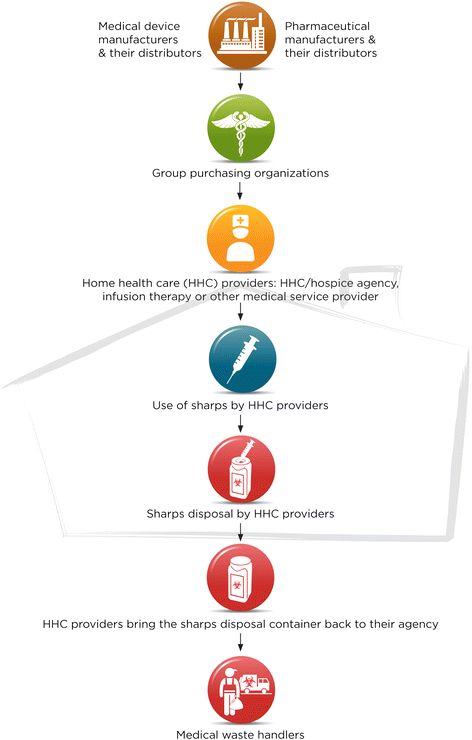Understanding sharps injuries in home healthcare: The Safe Home Care qualitative methods study to identify pathways for injury prevention
- PMID: 25885473
- PMCID: PMC4414288
- DOI: 10.1186/s12889-015-1673-x
Understanding sharps injuries in home healthcare: The Safe Home Care qualitative methods study to identify pathways for injury prevention
Abstract
Background: Home healthcare is one of the fastest growing sectors in the United States. Percutaneous injuries from sharp medical devices (sharps) are a source of bloodborne pathogen infections among home healthcare workers and community members. Sharps use and disposal practices in the home are highly variable and there is no comprehensive analysis of the system of sharps procurement, use and disposal in home healthcare. This gap is a barrier to effective public health interventions. The objectives of this study were to i) identify the full range of pathways by which sharps enter and exit the home, stakeholders involved, and barriers for using sharps with injury prevention features; and ii) assess the leverage points for preventive interventions.
Methods: This study employed qualitative research methods to develop two systems maps of the use of sharps and prevention of sharps injuries in home healthcare. Twenty-six in-depth interview sessions were conducted including home healthcare agency clinicians, public health practitioners, sharps device manufacturers, injury prevention advocates, pharmacists and others. Interview transcripts were audio-recorded and analyzed thematically using NVIVO qualitative research analysis software. Analysis of supporting archival material also was conducted. All findings guided development of the two maps.
Results: Sharps enter the home via multiple complex pathways involving home healthcare providers and home users. The providers reported using sharps with injury prevention features. However, home users' sharps seldom had injury prevention features and sharps were commonly re-used for convenience and cost-savings. Improperly discarded sharps present hazards to caregivers, waste handlers, and community members. The most effective intervention potential exists at the beginning of the sharps systems maps where interventions can eliminate or minimize sharps injuries, in particular with needleless treatment methods and sharps with injury prevention features. Manufacturers and insurance providers can improve safety with more affordable and accessible sharps with injury prevention features for home users. Sharps disposal campaigns, free-of-charge disposal containers, and convenient disposal options remain essential.
Conclusions: Sharps injuries are preventable through public health actions that promote needleless treatment methods, sharps with injury prevention features, and safe disposal practices. Communication about hazards regarding sharps is needed for all home healthcare stakeholders.
Figures


Similar articles
-
Sharps injuries in healthcare waste handlers.Ann Occup Hyg. 2008 Jun;52(4):281-6. doi: 10.1093/annhyg/men010. Epub 2008 Apr 29. Ann Occup Hyg. 2008. PMID: 18448444
-
Disposal of sharps medical waste in the United States: impact of recommendations and regulations, 1987-2007.Am J Infect Control. 2012 May;40(4):354-8. doi: 10.1016/j.ajic.2011.04.328. Epub 2011 Aug 6. Am J Infect Control. 2012. PMID: 21824683
-
Dangers of used sharps in household trash: implications for home care.Home Healthc Nurse. 2007 Oct;25(9):602-7; quiz 608-9. doi: 10.1097/01.NHH.0000296119.71814.f7. Home Healthc Nurse. 2007. PMID: 18049258 Review.
-
Sharps injuries and bloodborne pathogen exposures in home health care.AAOHN J. 2008 Jan;56(1):15-29; quiz 31-2. doi: 10.3928/08910162-20080101-02. AAOHN J. 2008. PMID: 18293597 Review.
-
Sharps disposal containers.Health Devices. 2003 Jul;32(7):253-72. Health Devices. 2003. PMID: 12961797
Cited by
-
Barriers and facilitators to infection prevention practices in home healthcare: a scoping review and proposed implementation framework.Infect Prev Pract. 2024 Jan 30;6(1):100342. doi: 10.1016/j.infpip.2024.100342. eCollection 2024 Mar. Infect Prev Pract. 2024. PMID: 38357520 Free PMC article.
-
Safety Risks Among Home Infusion Nurses and Other Home Health Care Providers.J Infus Nurs. 2017 Jul/Aug;40(4):215-223. doi: 10.1097/NAN.0000000000000227. J Infus Nurs. 2017. PMID: 28683000 Free PMC article.
-
Exploring Internal Conflicts and Collaboration of a Hospital Home Healthcare Team: A Grounded Theory Approach.Healthcare (Basel). 2023 Sep 7;11(18):2478. doi: 10.3390/healthcare11182478. Healthcare (Basel). 2023. PMID: 37761676 Free PMC article.
-
The Experience of Home Parenteral Therapy: A Thematic Analysis of Patient Interviews.Pharmacy (Basel). 2023 Aug 22;11(5):133. doi: 10.3390/pharmacy11050133. Pharmacy (Basel). 2023. PMID: 37736903 Free PMC article.
-
Factors Associated with Improving Appropriate Medical Sharps Disposal Practice Among Diabetic Patients Using Insulin Therapy.F1000Res. 2023 Dec 8;12:1290. doi: 10.12688/f1000research.141978.3. eCollection 2023. F1000Res. 2023. PMID: 38099003 Free PMC article.
References
-
- Bureau of Labor Statistics: Employment Projections: Fastest growing occupations. U.S. Department of Labor. http://www.bls.gov/emp/ep_table_103.htm (2013). Accessed 4 Mar 2015.
-
- National Association for Home Care & Hospice: Basic Statistics about the Home Care. http://www.nahc.org/assets/1/7/10HC_Stats.pdf (2010). Accessed 4 Mar 2015.
-
- National Research Council. Health Care Comes Home . The Human Factors. Washington, DC: The National Academies Press; 2011.
-
- Haiduven D, Ferrol S. Sharps injuries in the home health care setting: risks for home health care workers. AAOHN J. 2004;52(3):102–8. - PubMed
Publication types
MeSH terms
Substances
Grants and funding
LinkOut - more resources
Full Text Sources
Other Literature Sources
Medical
Miscellaneous

